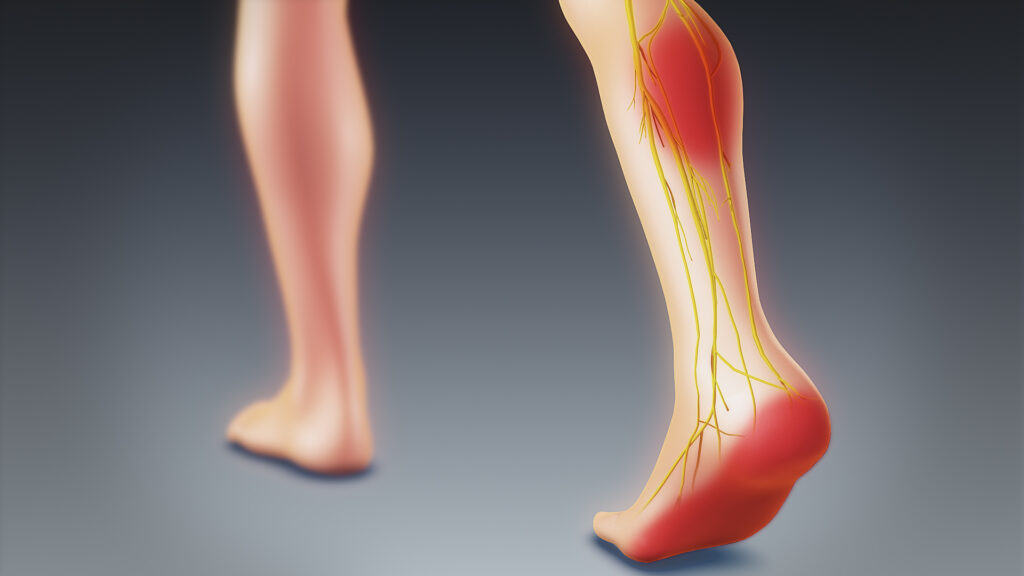Sciatica
Can Sciatic Nerve Pain Cause Numbness in Feet

Numbness in the feet can be a sign of sciatica, which affects the nerves in the lower back and down to the foot. People with this condition experience tingling or numbness when they move or change positions, which can lead to severe pain and weakness in the foot. There are many different treatments for sciatica. Some include stretching and massage, while others involve medications and biomechanical adjustments, such as orthotics. A doctor may also recommend surgery if conservative self-care methods are unsuccessful. If you’re experiencing sciatic pain consult your doctor to determine the cause of your pain.
Symptoms of sciatica can be widespread. In severe cases, you may experience numbness and weakness in one or both legs. Sometimes, the pain will also radiate to the buttocks or feet. In some cases, the pain can be caused by a herniated disk or an overgrowth of bone on the vertebrae. In other cases, sciatica can be caused by age-related changes in the spine.
Will Foot Numbness From Sciatica Go Away?
If you’re experiencing numbness in your foot, you may have sciatica. In addition to causing muscle weakness, it can also cause chronic pain. It may also result in a drop foot, which makes walking nearly impossible. In order to make the right treatment decision, it is important to understand the options. The pain caused by sciatica can range from mild tingling to sharp pain. In severe cases, the pain may become so excruciating that the patient may be unable to walk. In addition, sciatica can cause muscle weakness on the outside of the leg. The pain may even cause the person to walk on tiptoes, which is an uncomfortable sensation.
The symptoms can vary from person to person depending on the location of the pinched nerve in the lower back and the individual’s anatomy. Besides treating the symptoms, you should also find out the underlying cause of the problem. If the sciatic nerve is inflamed or pinched, then you’ll need to find a way to fix it. Sciatic nerve inflammation can be caused by lifting a heavy object.
How Do You Know If Sciatica Is Serious?
A physical exam can help the doctor determine whether sciatica is caused by a herniated disk, bone spur, or other problems. During the exam, your doctor may ask you to do exercises to help you relieve the sciatica pain. This may include walking on your toes or raising one leg while lying on your back. The doctor may also perform imaging tests to check for bone spurs or herniated disks. Electromyography tests can also identify a compressed nerve.
Different people experience sciatic pain differently. Some experience sudden, sharp pain while others experience gradual pain over time. Sometimes the pain may even be worse when you stand or walk, which puts more pressure on the sciatic nerve. If your symptoms persist, you may need aggressive treatment. For some patients, conservative self-care therapies may not give you any relief. The best treatment for sciatica is to determine the cause of your sciatica. A doctor can prescribe medication or other non-surgical measures to relieve the pain. Non-surgical treatment will help reduce inflammation and relieve the pain associated with sciatica.
Does Sciatica Show Up In MRI?
A sciatica MRI is a type of diagnostic imaging that uses radio waves and a powerful magnetic field to create detailed pictures of the internal structure of the body. A sciatica MRI can be helpful in determining whether you have a fracture or cancer, or if the problem is caused by a soft tissue problem. It can also be a great help in treating sciatica. However, if the sciatica you are experiencing is caused by a herniated disc, MRI scans may be ineffective in diagnosing the underlying cause of the condition. In such a case, magnetic resonance neurography (MRN) may be a better method. However, if you’re worried that your sciatica is caused by a fracture, an MRI may be the best way to find the culprit.
A sciatica MRI is usually conducted when the pain is caused by a herniated disk, which causes pressure on the sciatic nerve. Discs are the cushioning pads between the vertebrae in the spine. In a herniated disc, pressure from the vertebrae can cause the gel-like center of the disc to bulge and put pressure on the sciatic nerve.
Is Walking Good For Sciatica?
In order to reduce pain and stress in the lower back, walking is one of the best exercises for people with sciatica. It strengthens core muscles and strengthens lower back muscles. However, you have to be careful and follow certain guidelines when exercising. First, you need to maintain a proper posture. Your chin should be level with the ground and your shoulders should be relaxed. It is important to note that each person’s sciatica is different.
Some people may experience relief by walking several times a day, while others may only benefit from a short walk a couple of times a week. In any case, it is important to listen to your body and gradually increase your walking routine. In addition to standing upright, walking should be done carefully. Walking with a bad stride can cause the sciatic nerve to be irritated. A good stride should be smooth and even. You must also avoid sudden and jerky movements. Walking with sciatica may also cause weak legs and ankles, which will increase the risk of falling.
How Long Does It Take For Sciatica To Disappear?
Sciatica is a painful condition in the lower back and legs that is typically a short-term problem, lasting between six and twelve weeks. In severe cases, treatment may include surgery or steroid injections in the spine. A physician can also recommend physical therapy to treat the underlying cause. Physical therapy can help patients with sciatica manage the pain and improve their range of motion.
There are several causes of sciatica, including osteoarthritis and trauma to the lumbar spine. It can also be caused by a tight piriformis muscle, which places pressure on the sciatic nerve. Sciatica is a common complaint – 40% of Americans visit a healthcare provider for it. Some people may also suffer from cauda equina syndrome, which affects the bundle of nerves at the end of the spinal cord. This condition can lead to pain in the lower leg, numbness around the anus, and loss of bladder and bowel control. Alternative therapies are becoming popular for patients suffering from sciatica. They may include massage or biofeedback, which can help patients deal with pain and stress. Spinal surgery is usually reserved for patients with extreme pain and weakness, or for those who have no other option.
Can A Pinched Sciatic Nerve Cause Foot Numbness?
When the sciatic nerve is pinched, it results in leg pain or weakness. This problem can be caused by a variety of reasons, including degenerative disc disease, osteoarthritis, or spinal bone misalignments. Fortunately, the best treatment for sciatica is chiropractic care. Red Mill Chiropractic has helped many people find relief from their pain by treating the root of the sciatic nerve – subluxation.
When you have sciatica, you feel pain and weakness in your legs, buttocks, and feet. The pain usually begins in one leg and then spreads outward and downward. In some cases, the pain is more severe when you’re standing up straight or lying flat on your back. Avoid lying on your side if your pain is coming from the sciatic nerve. If the pain in your leg continues for a long time, it may be a sign that your sciatic nerve is being pinched. The pain in your leg may feel like an electric shock. If the sciatic nerve is pinched, it may also feel numb. It can be uncomfortable or debilitating, depending on the severity of the condition.
Is Numbness In Foot Permanent?
Numbness in the foot can be a symptom of a serious health problem. It is a sign of nerve damage and should be treated by a doctor. However, some cases of numbness may be temporary. If you experience numbness in the foot that doesn’t go away after a few days, you should see a medical professional. The doctor will be able to determine what’s causing the problem and what the best course of treatment is.
Numbness in the foot is a common problem. It can range from a small amount of numbness caused by sitting in one position for too long to a serious medical condition. It can be a sign of nerve damage or restricted blood flow to the foot. The most common vascular cause of foot numbness is peripheral artery disease. This condition causes the arteries to narrow and restrict blood flow to the foot. Nerve damage in the foot can affect the entire nerve cycle and cause it to lose sensation. The nerves that are responsible for the sensation of touch, light, and heat can be damaged and cause numbness. When this happens, the nerves in the foot cannot function properly. When blood flow returns, the sensation is restored to the foot.






















